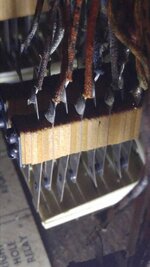When it comes to troubleshooting EMs, you need to take it somewhat systematically (I'm no expert on specific "tricks" to identify problems but I have troubleshooted enough of them to understand the basics).
It helps to understand how to trace a circuit using an Ohm meter (you clip one end at a certain point in the circuit sequence as you follow the startup and see if you can find an open circuit or a high resistance). But that requires a bit of experience, schematics, and know the order that everything happens in.
First rule of thumb is NEVER clean switches until it's all working, and then clean and test in sections so that if something goes wrong you'll know the area you last worked on. Very often people start out with a non-working EM and think "If I just clean all the contacts, it should work." Problem with this approach is that you often just introduce multiple issues. Always get a machine troubleshooted in sequence of how it starts, or address the most likely suspects first so that it is at least operating correctly, and THEN go back and do the fine tuning and cleaning that may make it sing.
What happens very often when you file contacts is that grit remains between the pads keeping them apart enough not to contact, or just enough to create additional resistance (that combines with other issues to form an artificial disconnect). You need to run a rough piece of card stock paper between the contacts after filing to clean them (or blow them out with a "little" air, a LOT of air can move switches out of position in their stacks). Also, very often switches "jump tracks" in the switch stacks due to mishandling or a bump or caught shirt here and there. So go back to those stacks you adjusted, get down with a good light and manually rock them back and forth to make sure they are all contacting and un-contacting as they should. If you see a pair that is ALWAYS closed, or ALWAYS open, then you know that one of the switch leaves isn't in the right rung of the stack ladder. While you are down there, check that there aren't any loose wires or solder joints.
A set of schematics is also useful because they will show the anticipated relay positions (determined by which switches are open and closed) at the start of the first ball after a credit has been used ( I think, it's something I am plucking from my now faulty 50+ year old memory.)
You said that the tilt relay was potentially out of whack. If the motor runs through a cycle and then won't start again or accept a credit, you should check the slam switches and the tilt relay and circuitry, and then the credit circuitry and credit reel and associated switches and relays.
What does also often happen is that the motor gets to a part of a sequence where it expects a switch to be thrown, but it isn't, stopping the sequence in its tracks. Number one culprit, shrunken switch spacers. There is no harm in tightening the switches in their blocks to take up any slack introduced by this shrinkage (although sometimes, especially for the timing switches around the motor, you may have some gapping adjustments to do.
Usually what you do is start there, and with power off, manually take the main start motor through it's rotation and watch all the switches carefully until you see one that "should" be contacting, but isn't, then make an adjustment so it contacts at the right time. Then try restarting the machine. Occasionally you have to manually throw one of the start or tilt relays to get the sequence started again. Vague, I know, it's been a while since I've done an EM.
Getting to your specific issue, often the motor runs (and won't stop) because the machine is trying to reset the score reels and since those relays and their corresponding rotary contacts are always in motion, they do tend to go out of spec. Even if the reel says "0" in the window, it's zero switch may not be contacting.
Read
https://havepinwilltravel.wordpress.com/intro-to-em-pinball-machines-and-their-schematics/
and then read and re-read:
http://www.pinrepair.com/em/index.htm too.
It took me Clay's resource, a course in early electronics (from decades in my past) and a couple books written on the subject of EMs to really get into the whole aspect of switch relays and their intended sequences in EMs. ;-)

